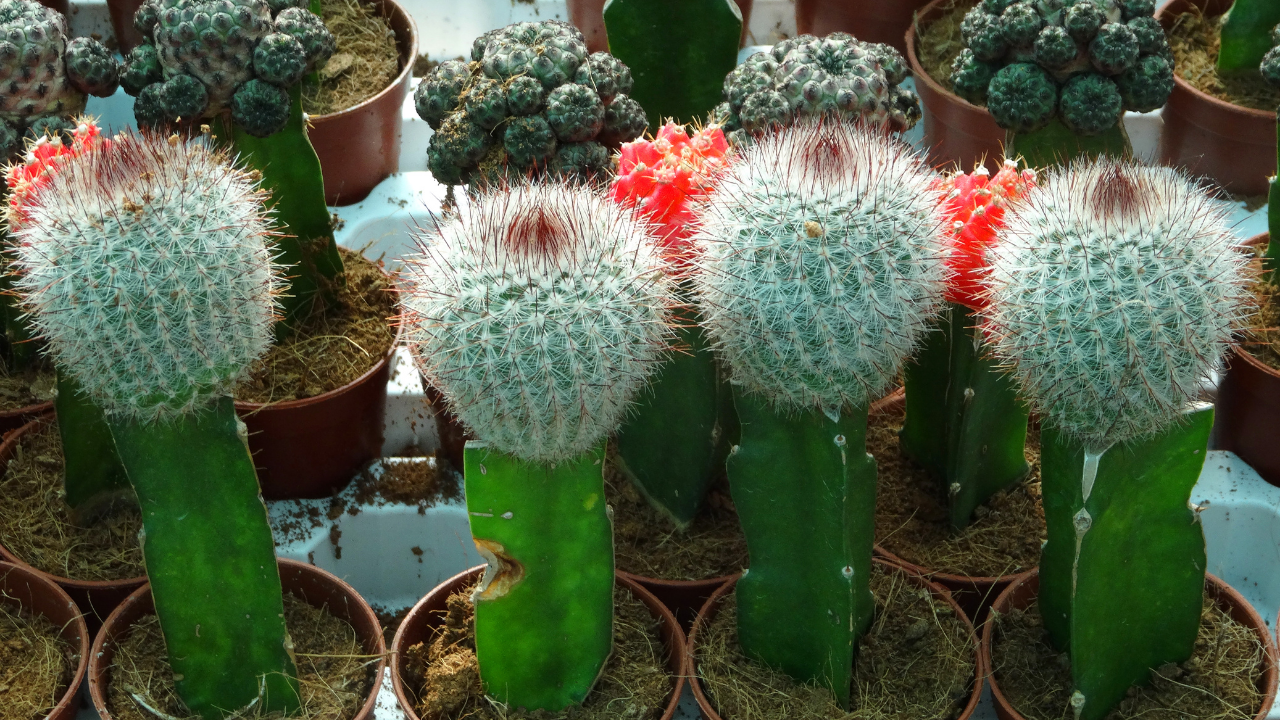
Have you ever seen a cactus plant that is of one color, maybe green, lower down and has a bright red top? Or a cactus that has a shape for what looks like the stalk, and then changes shape in its upper part? If so, you have seen what a grafted cactus looks like.

(Here are some photos of a grafted cactus)
What does grafting a cactus mean?
In gardening terms, grafting means joining a plant with another plant, or attaching a branch (or similar part) of a plant on top of another plant. It is common with many flowers and fruit trees, so that the lower, often wild and stronger part, can better support the higher, fruiting and flowering part and give it strength.
This is also very common with cacti: you cut a cactus, attach a part from a different cactus, and the wait till the two become one plant, but with different shapes and / or colors.
It’s a bit like an operation, like adding a finger to someone who’s lost it... But unlike operations on Humans, on cactus plants it is quite easy, and it has a very high success rate.
Why Should You Graft a Cactus?
There are a few reasons why you may wish to graft a cactus:
- To grow a weak species on top of a stronger one; this will give the weak plant thee energy of the stronger one.
- To save a dying cactus; if a cactus is so badly compromised that you can only save a small part of it, grafting will give you better chances of saving it than propagating it by cutting.
- For aesthetic reasons; this is very common, especially with small cacti like pincushion cactus (Mammillaria), mixing colors and shapes to produce a beautiful or contrasting effect.
How Do You Call the Parts of a Cactus Graft?
First of all, before we move on into the technique, you need to know how gardeners call the different parts of the graft:
- The rootstock is the lower part of the plant, the one with roots and that yo cut so that you can grow another species on top of it. Choose a strong plant.
- The scion is a cut from a different plant that you attach to the rootstock. This will not have roots, but it will become one with the rootstock and grow from there, forming the graft.
Choosing a good species as rootstock is essential to the success of your graft, as is choosing a strong, well established and adult plant.
Here are some species of cacti that gardeners think excellent as rootstock:

- Cereus peruvianus
- Harrisia jusbertii
- Hylocereus trigonus or undatus
- Mammillaria bocasana, lloydii or prolifera
- Myrtillocactus geometrizans
- Trichocereus spachianus
Easy Steps to Graft a Cactus
Ok then, ready for it? Follow these steps carefully and you will see that grafting cacti is not just easy, but fun and it can even be very creative.
Unless you are experienced, start with a small cactus, one you can handle well and which is in a small pot.
You will need:
- A sharp blade (a grafting knife is ideal, but a pruning knife or sharp knife will do, but make sure it is really sharp!)
- Some alcohol or apple cider vinegar and a clean cloth (tissue etc.)
- A few rubber bands (one should do, but just in case).
- A good rootstock plant which is growing, so in the vegetative phase.
- A healthy and young piece of another cactus to turn into the scion.
- Maybe a pair of gloves.
What to do:
- First of all, make sure that the top of your rootstock plant is growing (you can see it is lighter in color and it looks young.)
- Sterilize your blade with alcohol or apple cider vinegar. Do not underestimate this, blades carry infections from plant to plant and you will use it on an “open wound”.
- Turn it over on its side on a table and with a clear incision, cut about 1/2 inch to 1 inch from the top, exposing a full section of the inside (meristem) of the cactus stalk.
- Done? If the cut did not come outperfectly smooth and neat,correct it now.
- Now, cut all around the top of the cactus at a 45o angle. This means, around the flat section you have just exposed. This should be a small cut, of a few millimeters (5 mm or 0.4 inches) leaving the central part of the exposed stalk untouched. You now have your rootstock ready.
- Sterilize your blade again.
- Now, turn to the plant you want to graft on top of it. Choose a nice, healthy section from the top, where it is still growing.Cut a flat, dome like section. Check that the surface you have cut is healthy and smooth. Now you have your scion.
- Now, place the scion on top of the rootstock The cut part of the scion should be in full contact with the cut part of the rootstock. Do not worry if part of the roostock’s exposed tissue is not covered though - it will soon heal.
- Now, place a rubber band on top of the scion and wrap it under the pot.The rubber band should steady the two parts but make sure it is not too tight, or it will damage the scion. This will hold the scion in place till the graft is done.
- That’s it! Keep an eye on your graft and in about two weeks, you should see that the scion starts growing. At that stage it means that your two cacti have become one little plant and you can remove the rubber band.
CTTO: PLANT IT
How Much Water Does a Grafted Cactus Need?
A good question with a simple answer: exactly the same as any other cactus… Just water it when the soil has dried up completely and never be tempted to over-water it.
Remember that cacti have a very slow metabolism, it takes even a small cactus a few inches tall a whole week to bring water from the roots to the top. So, don’t expect an immediate improvement if you water a thirsty cactus (that maybe is losing turgidity). give them time!
Troubleshooting: Why Is My Grafted Cactus Dying?
To start with, this should not happen, but if it does, the most common causes are:
- Overwatering, in which case, stop watering immediately.
- An infection, in case you have not used a sterile blade or some other infection has set in: look at the graft scar to see if there is any change of color and texture. If so, then the wound got infected.
- The rootstock was not in the vegetative phase; it may happen that if the rootstock was dormant, which will cause the scion not to graft, then, when it dies, it infects the rootstock itself and the whole plant dies.
- If the two species are not compatible, the graft is more likely to fail, so, choose well tested roostocks.
Cactus Grafting - A Fun Activity!
As you can see, cactus grafting is a simple and straightforward technique, which even amateurs can accomplish very successfully. Just be careful with the instructions, use sterile blades etc, and it will all be fine.
But now imagine doing it with your children… Cactus grafting is creative, educational, it teaches them to love Nature and a craft that can be useful in their future, but above all, it can be a good chance for some quality time and fun!
Are you interested in growing your very own Cacti and Succulents? We got our very own Cactus and Succulent grow kit for you that is available via our website or via Amazon.





